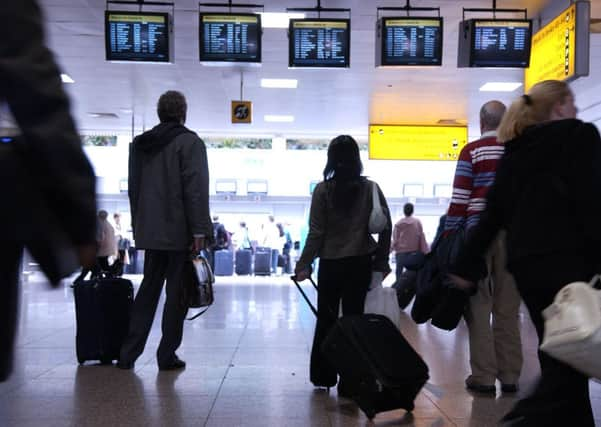Almost half of all UK air passengers fly alone


Nearly half of passengers fly alone and hardly anyone still gets the traditional wave off from family or friends, its research showed.
Aberdeen Airport, which is dominated by offshore traffic, was second only to business gateway London City in having the highest proportion of lone fliers - 72 per cent.
Advertisement
Hide AdAdvertisement
Hide AdThe CAA said 49 per cent of passengers flying in and out of the UK’s major airports last year travelled solo.
Just 4 per cent were waved off from the airport, with the figure for business travellers being as low as 2 per cent.
A total of 8 per cent of travellers got send-offs from Aberdeen, and only 3 per cent of those from Edinburgh and Glasgow.
Edinburgh has sought to deter so called “kiss and fly” travel to the airport by introducing a £1 drop-off charge for cars four years ago.
However, 44 per cent of passengers from Inverness were bade farewell, which may reflect the more limited public transport links than at the larger Scottish airports.
Of the 13 airports surveyed, London City had the highest proportion (74 per cent) of lone passengers last year, with East Midlands having the least - 24 per cent.
It was 63 per cent at Edinburgh, 55 per cent at Inverness, and 53 per cent at Glasgow - which has more holiday flights.
Overall, 86 per cent of business travellers flew alone in 2013, with 64 per cent of those visiting friends or relatives also being lone travellers.
Advertisement
Hide AdAdvertisement
Hide AdJust 19 per cent of those flying off on holiday travelled on their own.
Thirteen airports took part in the survey - Birmingham, East Midlands, Edinburgh, Gatwick. Glasgow. Heathrow, Inverness, London City, Luton, Manchester, Newcastle and Stansted.
The survey showed London City has the highest proportion of passengers travelling for business (55 per cent), with the next highest being Heathrow (30 per cent).
Airports with the highest proportion of leisure passengers were East Midlands 92 per cent, followed by Gatwick and Luton (both 87 per cent).
Travellers from Heathrow took a higher proportion of trips (23 per cent) lasting more than two weeks, with London City lowest at 3 per cent.
Outside London, Manchester had the most (14 per cent).
Unsurprisingly, Heathrow had the highest proportion (37%) of connecting passengers, being the UK’s sole hub airport and the world’s busiest for international flights. This was unchanged on 2012.
A total of 9 per cent of Gatwick’s passengers changed flights there, with all the other airports surveyed having fewer than 4 per cent, with East Midlands lowest at 1 per cent.
Heathrow (60 per cent) and London City (52 per cent) were the only airports where the majority of passengers were foreign residents (60 per cent and 52 per cent).
Inverness had the smallest number (11 per cent).
Advertisement
Hide AdAdvertisement
Hide AdCAA regulatory policy director Iain Osborne, said: “Our annual survey data shines a light on the latest passenger trends and needs, providing an invaluable insight for the aviation industry.
“For example, do airports know how few people are being waved off, have they considered why and does this have implications for drop-off facilities?
“While there are many excellent viewing facilities at UK airports, our passenger survey data tends to suggest they are not being used that much, and this may highlight a missed commercial opportunity.”
A spokesman for Edinburgh Airport said: “About 62 per cent of our passengers travel alone, and this has remained pretty consistent over the last four years, and reflects our passenger profile.”
SEE ALSO: